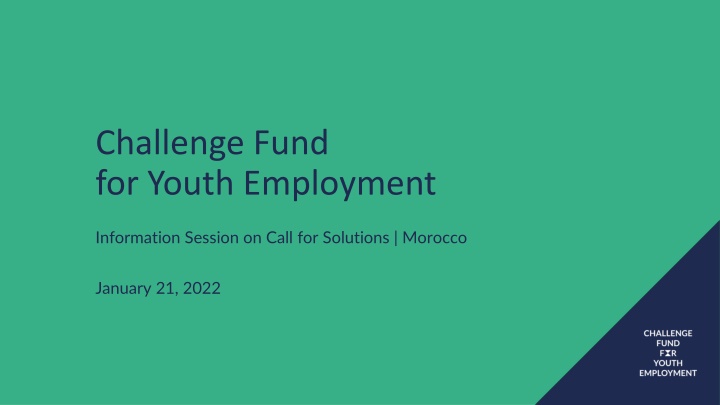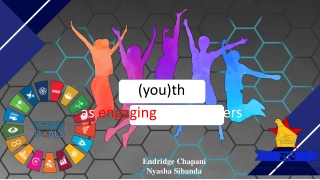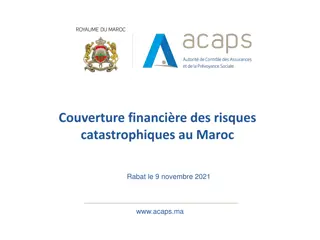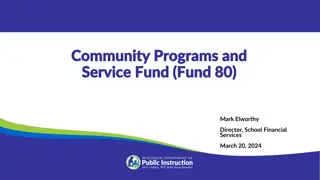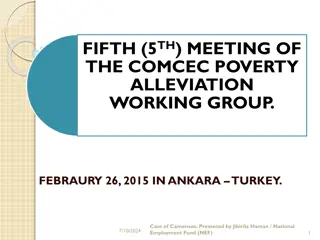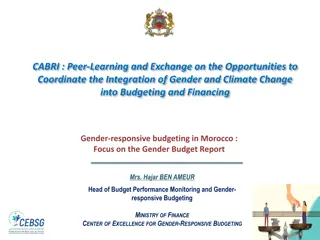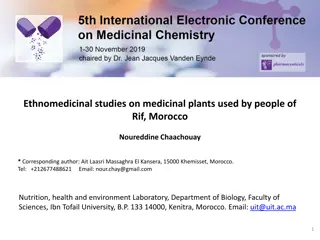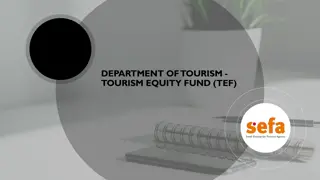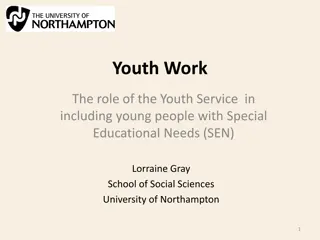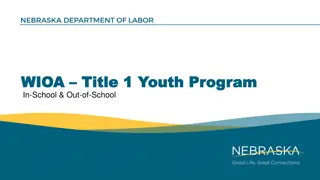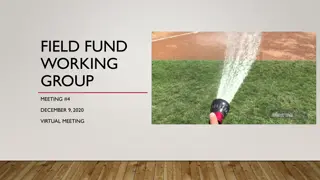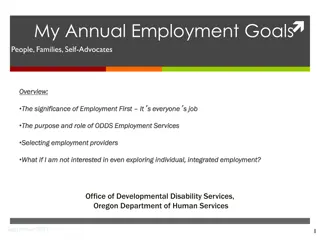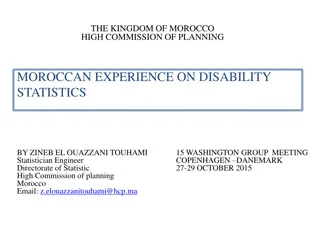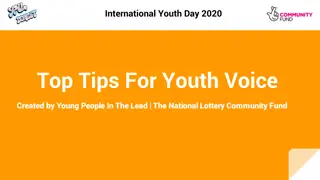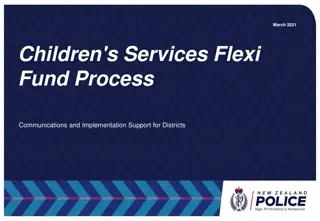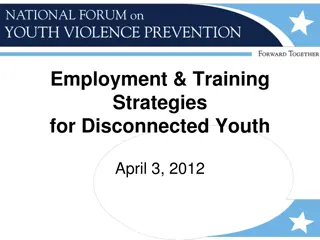Youth Employment Fund Information Session in Morocco
A detailed overview of the Challenge Fund for Youth Employment, discussing goals, approach, partners, and offerings. Learn about opportunities for creating decent employment for young people in Morocco and other regions by 2025.
Download Presentation

Please find below an Image/Link to download the presentation.
The content on the website is provided AS IS for your information and personal use only. It may not be sold, licensed, or shared on other websites without obtaining consent from the author.If you encounter any issues during the download, it is possible that the publisher has removed the file from their server.
You are allowed to download the files provided on this website for personal or commercial use, subject to the condition that they are used lawfully. All files are the property of their respective owners.
The content on the website is provided AS IS for your information and personal use only. It may not be sold, licensed, or shared on other websites without obtaining consent from the author.
E N D
Presentation Transcript
Challenge Fund for Youth Employment Information Session on Call for Solutions | Morocco January 21, 2022
Agenda Introduction 5 mins The Fund explained 15 mins Scoping Research: The Challenge in Morocco 25 mins Call for Solutions & Selection Priorities 15 mins Application and Submission process 5 mins FAQs and Q&A 25 mins
Who is on this call? Nimrah Karim: Country Lead, Morocco Sanae El-Ouali: Portfolio Development Consultant Lhoussaine Wahib: Research Consultant Nour Serry: Manager, CFYE Meriem Boukhari: Associate, CFYE Luc Shillings: Head Economic Affairs Adil Rataib: Economic & Trade Affairs Officer Embassy of the Kingdom of Netherlands, Rabat
Pigeonhole Explained Pigeonhole allows you to: Ask questions as you think of them Vote for your favourite questions Questions are totally anonymous Time allocated at the end for CFYE team to answer all questions To submit a question, go to the website www.pigeonhole.at and enter the password 8BZCRR
The Challenge Fund for Youth Employment About the Fund
The Challenge Fund Explained Decent employment for 200,000 young people By 2025, the fund aims to create decent employment for 200,000 young people including 100,000 women in the Middle East, North Africa, West Africa, and the Horn of Africa (including Kenya and Uganda). Goal Competitive challenges with focus on young women Approach We will run several competitive context-specific challenges per year to address supply, demand, or job- placement constraints to creating more jobs and/or improving the quality of work for people, especially women, aged 15-35 in the focus countries.
What the Fund offers Co-investment Technical Assistance The Fund will co-invest a maximum of 50% of the total project budget. In-kind technical support will be available throughout the selection process and during implementation to maximise delivery of results. The total project budget must have a minimum value of 200,000 Euro. We will support approximately 5-7 projects in Morocco
Applicants will propose how they will... Create Match Improve A young person takes up a job that has been newly created as a result of the CFYE co-funded intervention A young person is matched with, or finds a job that may or may not have existed prior to the CFYE co-funded intervention A young person experiences improvements in working conditions within an existing job or business activity as a result of the CFYE co- funded intervention
Selection Criteria Private sector- driven Engaging Youth Including Women Clear pathway to decent work Involve a private sector partner and have a local presence Young people should be directly involved in the design of the solution Young women must be included and able to benefit, considering specific barriers women face Demonstrate how project will result in at least 250- 500 young people working in decent jobs or experiencing improved conditions
Where are we now? Projects in implementation phase Uganda, Egypt, Nigeria Projects in Inception Phase Kenya, Jordan, Sudan Upcoming Countries for Launch Uganda, Ethiopia, Morocco, Senegal, Tunisia, Burkina Faso
Two Key Workstreams Portfolio Development In-country Research Publish call Establish pipeline Engage directly with prospects, analyze feasibility and fit Desk study Key Informant Interviews Understand root causes unemployment Youth Aspiration Sessions Deliverable: A strategic call where CFYE can play an additional role in YE promotion Deliverable: Pipeline of engaged, high quality applicants Deliverable: Scoping Report What are sustainable business opportunities that meet the objectives of CFYE?
Challenges & Opportunities in Morocco Key findings from Scoping Research
Create Challenges Opportunities Export-driven growth for SMEs in key sectors and aligning to int'l standards Growth sectors include agribusiness and industries such as automotive, aeronautics and the textile. New market demand, especially for women, in e-commerce and business development through digital innovations Business development support and access to finance can help SMEs improve in growth and job creation. Traditional private and public sector organizations not able to absorb new entrants to the labor market SMEs face constraints to growth such as low access to finance and low access to markets Startups are likely to fail in the first two years or stay micro-sized, with limited job creation. High levels of informality within SMEs.
Match Challenges Opportunities Successful matching model developed by the public-private partnership with TVET institutions in emerging sectors (automotive, aeronautics, and textiles). Successful emerging initiatives of training combined with job placement. Importance of digital platforms for hiring (Linkedin, etc). Relatively developed network of recruitment and placement firms with close monitoring of the market and innovative approaches towards recruiting. Persisting gap between education outcomes & employer requirements. Information on job openings remains sparse and unreliable. A dearth of job matching platforms and reliance on personal networks for both hiring and finding job opportunities. Difficulties for inexperienced fresh graduates to find jobs. Challenging to find internships.
Improve Challenges Opportunities 55% of wage workers are employed in informal jobs. Formal wage employment is dominated by males Labour regulation and decent work requirements apply to only a minority of the workforce Informality of jobs impacts women more than men and is prevalent in the rural areas where most men and women work as family workers There is high political commitment toward women inclusion and job formality: The New development Model recently adopted aims to increase the FLFP to 45% and formal jobs share to 80%. There is increased awareness toward decent jobs requirements, especially for women, in certain sectors (textile, etc) ICT sector is a promising alternative for women to get flexible working opportunities.
Youth Aspiration Sessions - Key Outcomes Aspirations Categories Main challenges Opportunity for CFYE to Support... Lack of job opportunities due to a weak private sector. Less developed regions with ltd opportunities for self- employment. Jobs with a steady salary, mainly in the public sector. Transparent and inclusive access to public sector jobs. Financial and technical support programmes for self- employment and entrepreneurship tailored to the specificities of these regions. Expansion of decent job opportunities by the private sector in remote regions Promotion of training + matching programmes tailored to prevailing sectors. Category 1:Youth based in remote areas Lack of information on available job opportunities. Available jobs are in the informal sector and don t meet decency standards. Lack of entrepreneurship support programmes for this category. Short technical training with low barriers to enrolment (required educational level etc.). Transparent access to information on job opportunities in the private sector. Support for entrepreneurship and self-employment based on simple processes and requirements. Expansion of decent job opportunities in the manufacturing and services sectors, catered to this segment. Promotion of inclusive training + matching programmes with minimum requirements to apply (in terms of required education level, etc.) Category 2: Low- skilled youth in urban areas Lack of information on available job opportunities, particularly in manufacturing sectors. Available jobs are in the informal sector and don t meet decency standards. Limited career progression opportunities within companies due to a lack of support and mentorship. Jobs in the formal sector with reasonable pay, healthy working conditions and a work-life balance. Training opportunities within companies with a clear path to professional development. Real mentorship within companies and transparent access to knowledge from the senior staff. Job opportunities in promising sectors such as the ICT. Internship + placement programmes for TVET alumnus in order to gain experience in targeted sectors Digital skills training + placement programmes in the IT sector Measures to enforce decent work conditions in the manufacturing sector (minimum wage, social security etc). Training on soft and transferrable skills, including language skills (English & Spanish). Category 3: Medium-skilled youth in urban areas with vocational training through TVETs Mismatch between the education outcomes and the real needs of the private sector. Job opportunities are below their qualifications. Low wages offered compared to expectations Tailored training to acquire the technical skills required by the private sector. Job offers taking into consideration the qualifications of this category of youth. Initiatives that bridge the gap between academia and industry (e.g. training + placement programmes). On the job technical training. Category 4: Medium to High- skilled youth/university graduates in urban areas
Promising Sectors Automotive: Expected to create 66,500 new jobs and includes labor-intensive sub-sectors such as vehicle assembly and wiring. CFYE sees an opportunity to support local SMEs in the supply chain who have a high demand for medium to high-skilled labor. As the sector is male-dominated, there is opportunity for addressing barriers to entry for women. Aeronautics: Has a clear roadmap for development, supported by GIMAS, which is targeting creation of 23,000 new jobs and runs its own training and vocational education center. There is potential for absorbing high-skilled women in this sector, particularly in wiring. Textiles: Strategic importance due to its contribution to the labor market (employs 190,000+, 65% are youth). Potential for innovation in subsectors such as technical textiles. The sector is run by AMITH, which also runs its own training and vocational center in Casablanca. Pharmaceuticals: Strong due a well-developed local base of producers that manufacture products based on international standards. The government s push towards universal healthcare is expected to further boost local demand for pharmaceuticals. Agribusiness: With modern technologies and innovative agricultural practices, there is potential for the sector to achieve socially and environmentally sustainable agricultural solutions as well as attract youth to more tech-oriented jobs in this sector, for example through smart agriculture and digital platforms. ICT enabled jobs & offshoring opportunities across service sectors: Technological innovation will be strategically key to expand market opportunities at scale. This is a relatively crisis-resilient sector with high potential for hiring youth and women at scale. Based on our youth aspiration sessions, digitally-enabled opportunities align well with the interests of the youth.
Call for Solutions & Eligibility Criteria
Call for Solutions: Priority Windows The project must meet the minimum eligibility criteria for job targets through a combination of CFYE categories: create, match or improve. Window Description Minimum # of jobs impacted 250 jobs over 3 years 1 Co-investment in high-growth potential SMEs in the value chain of key manufacturing sectors (automotive, aeronautics, textiles, pharmaceuticals, and agri-business) 2 500 jobs over 3 years Matching programs for digital skills development + large scale employment through ICT-enabled jobs & offshoring across service sectors (e-commerce, education, health, finance, creative sector, etc.) Please note: While priority will be given to these windows, applications that fall outside these windows will also be accepted.
Examples of Potential Projects Create: SME in key manufacturing sector (ex. textile) expanding its production capacity to include new products. This will create job opportunities for youth and women, including on the job training. Create & Improve: Factory producing ready-made garments that is hiring new staff. Also, already has a considerable number of young women in its workforce, but a high turnover rate due to women leaving, willing to implement measures to keep them on board, such as child-care facilities at the factory, safe transport arrangements and/or maternity leave. Match: Consortium of E learning/training platform and private sector companies in ICT sector providing demand-driven digital training, and matching youth with available openings in these companies. Match: Company looking to expand operations outside of Casabanca that invests in skills development of young women in a remote region, followed by hiring of trained youth.
Applicant Profile We strongly invite applications from private sector companies, as we believe that private sector involvement is the most effective way to test market-based solutions that respond to the challenge of youth employment. We welcome partnerships or consortium responses to this challenge Non-profit entities are welcome to apply, but if they are the lead applicant, they must apply in consortium with a private-sector partner with confirmed labour demand. The applicant must be able to begin operations no later than October 2022. Additionality: CFYE co-financing must be additional to the proposed project, i.e., funding is channeled to bring about activities and further investments in youth employment which could not otherwise occur. The provision of funding must not substitute organisation s core funding, or crowd out other funding sources.
Budget Guidelines CFYE co-investment must be minimum 100,000. The range for CFYE co-investment is 20-50% of the total project budget. There is no maximum CFYE co-investment stipulated, but we will consider whether the budget is realistic and whether the applicant can raise the required co-funding. We will also assess if the CFYE cost per job is competitive. The suggested range for cost per job to CFYE (Total CFYE co-investment / total # of jobs) is between 300-800 Euros. Projects with a higher budget than this range may be considered if there is a compelling and feasible developmental additionality (e.g., very high inclusion of women or high inclusion of youth in remotely located areas). Projects that demonstrate value for money and cost-effectiveness will be viewed favourably during evaluation. The company s in-kind contributions must not exceed 30% of its total co-investment. Capital investment (CapEx) requests from CFYE must not exceed 33% of the total investment.
Selection Priorities Number of Jobs Value for Money (CFYE grant per job) Quality of the jobs (decency, sustainability) Value of co-funding by applicant Additionality Realistic impact pathway (labour- and market demand) It's a competitive process!
Application Process Timelines of application & selection, and submission process
Key Milestones of the Application & Selection Process 25 May 2-31 March 18 February 1-1 Coaching Sessions Post Evaluations Workshop Concept Note Submission 14 January Call Launch 2 March Concept Note Applications mapped with Coaches 15 April 21 January 1st June Business Case Submission 1st Launch Webinar Projects Awarded by Steering Committee 9 February 3-18 May 18 January 2nd Launch Webinar Field Visits/Interviews with Specific Applicants Scoping Report Published 27 February 19 April 2 May Concept Note Selection Selection Committee Evaluations 2 March Business Case Application Launch Webinar
What to Do If You Are Interested in Applying? Your main point of contact from CFYE will be an in-country representative and the Fund Management Team. They will be sending you the regular updates about the decision-making process of your submissions. They can be reached via morocco@cfye.nl
CFYE Portal submission Demo CFYE Organization Form (formtitan.com)
Access your Application Pack 1. Application & Selection brochure, with a process map and timelines 2. Concept Note template, with a guidance note 3. Business Case template, with a guidance note 4. Frequently-Asked Questions Refer to the Country-Specific page on the website
Frequently Asked Questions
FAQs Applicants Contribution 1. Is it possible to bring in existing projects as the applicant s contribution? Any other funding can be proposed if it is not earmarked or has already been spent on other projects. 2. Can grant funding from donors count as co-financing? Yes, as long as the grant does not come from the Dutch Government, except for venture capital or debt finance originating from the Dutch Government including the Dutch Good Governance Fund or FMO. The idea is that this would lead to an increase in impact. We will assess the level of additionality for each project. 3. How should the applicant value in-kind support as part of its contribution to the project (e.g. company staff that participates in setting up training or human resources programs)? In-kind support should be valued at market rates, and staff time budgeted as in-kind support must be reasonably justified as related to the project.
FAQs Fund Contribution 1. Do projects need to apply for a combination of financial investment and technical assistance, or one or the other? Applicants are invited to apply for a financial contribution, technical assistance contribution, or a combination. We don t expect to receive many proposals solely for technical assistance, but this is possible. It is also possible to request technical assistance later in the project. 2. What type of technical assistance support is offered complementary to the grant? Additional technical assistance (TA) that is offered depends on the need and type of project. Any capacity building that is essential to the project should be included in the project design and thus is part of the overall project budget. Additional TA refers to aspects that are not part of the project design per se, but can enhance the outcomes. The range of additional TA that can be offered is wide, including gender, financial management, decent work, monitoring & evaluation, etc.
FAQs Results & Impact 1. How does the Fund define decent work ? We are following the ILO s definition, which states, Decent work sums up the aspirations of people in their working lives. It involves opportunities for work that is productive and delivers a fair income, security in the workplace and social protection for families, better prospects for personal development and social integration, freedom for people to express their concerns, organize and participate in the decisions that affect their lives, and equality of opportunity and treatment for all women and men. Decent work will be defined and addressed as relevant for each project context. It may not always be a static assessment, but rather a process towards improvement across various specific areas such as working hours, productivity, income, better prospects, etc.
FAQs Results & Impact 2. Are there specific guidelines or standard indicators that should be referenced for measurements of youth employment (i.e. full-time, part-time, self-employed)? It would be helpful to have clear understanding of the nature of the jobs to which the proposed interventions would lead including a description of full time vs part time, self-employed vs. wage- earning, seasonal, etc. The only firm requirement is that the job must meet a certain standard of decency and income, which will be assessed on a project-by-project basis. 3. What are the criteria to make sure women benefit? At concept note stage, the project needs to demonstrate that it has considered the specific context of women, explain how women are able to benefit, and have a clear strategy for achieving this. 4. Are projects eligible that create jobs for people older than 35? Projects must demonstrate how they will create, match, or improve employment for people aged 15-35. If projects also aim to create jobs for people older than 35, they would still be eligible, but the Fund s employment target refers only to people aged 15-35.
FAQs Results & Impact 5. When do projects need to report on results? Projects will need to report on progress towards results targets at least biannually. The jobs target should be achieved by the end of the project (in principle, after 2-3 years), along with a plan for sustainability. 6. Are you accepting proposals that aim to create indirect jobs? Yes, this is possible as long as the project can demonstrate that it contributed to the indirect jobs, and that they can be measured and verified.
Questions? For more information: https://fundforyouthemployment.nl/ Pipeline & partnerships: Morocco@cfye.nl
